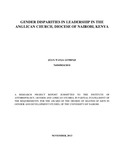| dc.description.abstract | According to the Laws of the Church of England, a woman can be ordained to lead in any seat in the Global Anglican Church. In Kenya though, the highest level of leadership that a female clergy has risen to is that of Canon; with there being no female bishops or archbishop since the first Church Missionary Services missionaries landed in 1844. This study sought to find out why there are gender disparities in leadership of the Anglican Church of Kenya, as well as how these disparities are manifested.
This study focused on the ordained leadership in the Diocese of Nairobi and was guided by two specific objectives. The study aimed to examine the manifestations of gender disparities in the church leadership of ACK, Diocese of Nairobi. The study also aimed to analyse the factors influencing these gender disparities.
Methodology
Cross-sectional descriptive study design was used as the methodology for this study. Nine In depth interviews were carried out with randomly sampled ordained clergy, one from each of the nine archdeaconaries in the Diocese. One key informant who is at the top of the administrative arm of the Diocese was interviewed. Two focus group discussions were held, and the roles of clergy leaders in Sunday liturgy, along the lines of their gender were observed in nine churches. The main findings of the study were that sex and marital status directly affect an ordained clergy's chances of rising in leadership level, and that Patriarchy and Societal Gender roles were the major causes of women not rising in leadership.
Findings
This study concluded that there indeed are gender disparities in the leadership of the Anglican Church of Kenya, Diocese of Nairobi, and showed that women are the ones not rising in leadership levels, roles and responsibilities.
This study recommended Affirmative Action whereby the church implements a policy dictating that no more that two-thirds ofthe ordained leaders in any Diocese should be of the same gender, and that male clergy second women to leadership positions for example to be reverends and
curates in their parishes' daughter churches. | en_US |

